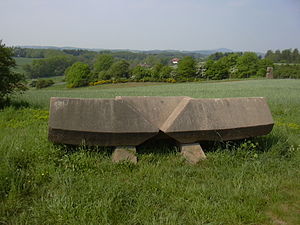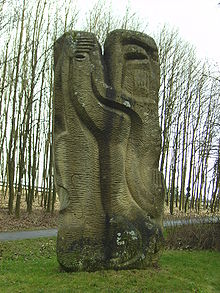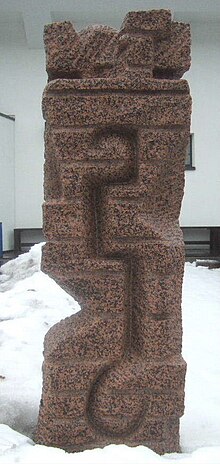Street of Sculptures (St. Wendel)

The street of the sculptures is located in the northeast of Saarland and leads from St. Wendel to the Bostalsee . The sculpture trail was initiated by the St. Wendel sculptor Leo Kornbrust in 1971. It is dedicated to the German-Jewish sculptor and painter Otto Freundlich who was murdered by the National Socialists and who came up with the idea of a street of sculptures in the 1930s. This road of brotherhood and human solidarity should lead from Paris to Moscow .
Since 1971, a total of 57 sculptures by 51 artists from 12 countries have been created and set up along an approximately 25 km long section of the Saarland circular hiking trail. It all started with the International Sculpture Symposium at Baltersweiler's height in 1971/72. This symposium was included in the Sculpture Street, which was worked on from 1977 to 1988. The route was expanded during the 1993 trilateral sculpture symposium. Between 1996 and 2001 five more sculptures were added. The steel sculpture “Tor für Leo” by Gerd Winner was installed in 2014 as the last work of art .
Development of the project
International stone sculptor symposium St. Wendel 1971/72

In the summer of 1971 the first Saarland sculpture symposium took place for three months on the heights near Baltersweiler . This year, apart from Leo Kornbrust, a total of 11 artists from four countries took part, including Karl Prantl , the initiator and founder of the world's first sculpture symposium in Sankt Margarethen in Burgenland . In the following year the action was continued with three other artists. A total of 14 stones were processed by 15 artists from six countries. With that the "International Stone Sculptor Symposium St. Wendel" was completed.
Expansion 1977-88


In the years 1974-75 the Saarland circular hiking trail was laid out, which leads over the site of the symposium near Baltersweiler. In this context, the idea of a "street of sculptures" arose. As a prelude, two sculptures were created in 1977, the “Fish Head” by the artist Han van Wetering and the “Big Foot” by the sculptor Yoshimi Hashimoto. The two sculptors Franz Xaver Ölzant and Leo Kornbrust officially opened the actual sculpture street with their works in 1979 . Other works by other artists followed. In 1988 the street was completed with the completion of the work by Dorothee von Windheim . By then, a total of 35 artists from 10 countries had presented their works. Together they created 38 sculptures of various artistic styles.
Sculpture Symposium 1993
In 1993 the International Society of Fine Arts in Bonn commissioned Leo Kornbrust with the project management of a trilateral sculpture symposium, which was held in the context of the 30th anniversary of the Franco-German Youth Office and the 25th anniversary of the Office franco-québécois pour la jeunesse in the " Grenzland “Saarland should take place. In the autumn of the same year 15 young artists came to St. Wendel. Nine of them created permanent works on the sculpture street; three created temporary projects in the landscape, two opted for a museum project in St. Wendel and one artist for a conceptual work that was also presented in the museum. The sculpture road was extended by 5 km to the Peterberg near Braunshausen .
The years 1996-2001
In the years 1996–2001 the street was expanded by five sculptures. Two of these were created in direct engagement with the surrounding landscape: a steel sculpture by James Reineking and the "cloud altar" by Herbert Wurm. The latter was the only sculptor who made his work on site. The remaining three sculptures were set up in consultation with the artists in the urban area of St. Wendel.
Involvement in the road of peace
→ Main article: Road of Peace
In 2002 the street of the sculptures was connected with the project “ Stones at the border ” near Merzig ; at the interface at Waderner district Gehweiler a plastic of the two initiators was a visible sign of the particular compound Paul Schneider and Leo Kornbrust erected. With the establishment of the Otto-Freundlich-Gesellschaft in 2004 under the direction of Leo Kornbrust, Freundlich’s idea is to be realized. By integrating other sculpture symposia and other sculptures by international artists, a road is to be created between the Norman coast and Moscow. Extensions of the "Strasse des Friedens" in Germany are the sculpture path in Salzgitter-Bad , the steel sculpture symposium in Dillingen / Saar , the marble sculpture "Waves of Life" by the artist Jaroslav Vacek in the European Academy in Otzenhausen and the sculpture symposium of the Foundation for Sculpture in Berlin . Further sections exist in Luxembourg , Belgium , France and Poland .
The artists and their works
| Artist | title | material | year |
|---|---|---|---|
| Hiromi Akiyama | Untitled | red sandstone | 1971/72 |
| Framework for a landscape | yellow sandstone | 1981 | |
| Gerd Ammann | Untitled | yellow sandstone | 1981 |
| Ivan Avoscan | Réveil - awakening | yellow sandstone | 1982 |
| Gabi Beju | Memory of the Nike of Samothrace | yellow sandstone | 1972 |
| Franz Bernhard | St. Wendeler figure | Sheet steel, welded | 1999 |
| Rinaldo Bigi | Barca della Vita - ship of life | yellow sandstone | 1983 |
| Daniel Bräg | Untitled | about 200 stacked spruces | 1993, disappeared today |
| Hans-Jürgen Breuste | Overkill 1982 - the forces of stones and the forces that cause stones to burst | yellow sandstone, tank tracks, steel plates, cannon barrels | 1982 |
| Sylvie Bussières | Formes végétaux: 4 arbustes, forme feuille, montagne | slate | 1993 |
| Elmar Daucher | shift | red sandstone | 1971 |
| Mario Duchesneau | Untitled | 45 whitebeam bushes | 1993 |
| Herbert George | Untitled | red sandstone | 1972 |
| Nikolaus Gerhart | Untitled | yellow sandstone | 1986 |
| Alfred Goerig | Wholeness - Postponed | yellow sandstone, steel plate | 1983 |
| Edgar Gutbub | Threesome | red sandstone, steel plate | 1984 |
| Nausicaa Hacker | Untitled | Sandstone, concrete | 1993 |
| Yoshimi Hashimoto | Big Foot | yellow sandstone | 1977 |
| Bruno K. | Hawthorn - stake in the flesh | Approx. 250 years old oak, iron plates, sheet metal, concrete base | 1981 |
| Kang Jinmo | Departure | Basalt lava, stainless steel | Established in 1994, 1999 |
| Leo Kornbrust | Homage to Buñuel | Basalt lava | 1971 |
| Love throne | yellow sandstone | 1979 | |
| pyramid | Basalt lava | 1988 | |
| Wolfgang Kubach and Anna Kubach-Wilmsen | Pillar of earth | Krastal marble , smoke crystal | 1971 |
| Dieter Kunz | triangle | Concrete casting | 1993 |
| Samuel La Roze | Anthill | Glass box, iron bars, sugar | 1993, disappeared today |
| Diane Landry | St. Wendel and the surrounding area | Iron, iron wire, wax, photos, found objects, wool | 1993 |
| Patrick Lebret | 2 installations "Avec Titre" | Material: 1) iron, pond liner, water, goldfish; 2) iron framework, pond liner, motor, water, dye | 1993 |
| Alf Lechner | Untitled floor object | 8 cm thick sheet steel | 1985 |
| Ulrike Leitz | Information pillar III | Sandstone, silicone, film strips, film cans, sand | 1993 |
| Christian Mayer (today: Christian Tobin ) | Canted | yellow sandstone | 1981 |
| Takera Narita | Horizontal development | red sandstone | 1971 |
| Mathis Neidhart | "Sanctuary" floor design | Asphalt, total length about 33 m | 1993 |
| Bertrand Ney | awakening | yellow sandstone | 2007 |
| Heinz Oliberius | Untitled | yellow sandstone | 1986 |
| Franz Xaver Ölzant | Remembering Hammurabi | Basalt lava | 1971 |
| Untitled (popularly called "Wolkenstein") | yellow sandstone | 1979 | |
| Karl Prantl | Basalt bank | Basalt lava | 1971 |
| James Reineking | Untitled | 40 cm thick sheet steel | 1996 |
| Laurent Reynes | Untitled | Wooden stakes, slate | 1993, dismantled in 1998 |
| Diane Robertson | Untitled | Iron, stones, gravel | 1993 |
| Gernot hull | Commemorating the mine disaster in the Schwerspatgrube iron | red sandstone with aluminum | 1971 |
| Adolf Ryszka | Landmark on the way | red sandstone | 1971 |
| Michel St-Onge | Fos ne l'en sof | Wood, stone, car tires | 1993 |
| Robert Schad | In the wind | steel | 2008 |
| Rudi Scheuermann | Composition with stereometric elements | red sandstone | 1971 |
| Michael Schoenholtz | Great double figure | yellow sandstone, concrete base | 1984 |
| Martin Schneider | Untitled | yellow sandstone | 1981 |
| Paul Schneider | View of the landscape | red sandstone | 1971 |
| Klaus Schwabe | Threatened family | yellow sandstone | 1987 |
| Alf Schuler | Wall piece | 2 steel pipes (length 5 m each) and steel cable (30 m) | 1985, 1998 detached |
| Wall piece ("eyelids") | over 30 pieces of steel pipe, two steel cables | 2007 | |
| Shlomo Selinger | Requiem for the Jews | yellow sandstone | 1980 |
| love | red granite | 1982, set up in 2010 | |
| Hans Steinbrenner | figure | Basalt lava | 1975 |
| Valérie Thuillier | Chemin amusé, amusing | 6 steel rings, each 2 m in diameter. | 1993 |
| Hajime Togashi | Sunstone | Krastal marble, smoke crystal | 1972 |
| AD Trantenroth | 3 changes in the environment without a title | Tombac | 1988 |
| Untitled | yellow sandstone, tombac, hinges, blue color | 1988 | |
| Franck Turpin | Untitled floor object | colored concrete, iron hinges | 1993 |
| Han van Wetering | fish head | red sandstone | 1977/78 |
| Dorothee von Windheim | Untitled | yellow sandstone, iron, glass | 1987/88 |
| Gerd Winner | Goal for Leo | steel | 2014 |
| Herbert Wurm | Bliesener Stein - cloud altar | yellow sandstone | 2001 |
Remarks
- ↑ Evelyn Schneider: Leo's gate to the street of peace. Online offer of the Saarbrücker Zeitung , April 15, 2014, accessed on April 17, 2014 .
literature
- Rena Karaoulis: The Street of Sculptures. From the St. Wendel sculpture symposium to the Street of Peace in Europe . Verlag St. Johann, Saarbrücken 2004, ISBN 3-928596-85-3 .
- Sculptures for Peace , in: Saarbrücker Zeitung (Ausg. St. Wendel) v. April 30/1. May 2009, p. C6
- Hans Weingartz : Street of Sculptures - From St. Wendel to the Bostalsee , Kid Verlag, Bonn 2011, ISBN 978-3-929386-33-2
Web links
- Information and photos about the Sculpture Street
- Road of peace
- Stones at the border ( Memento from February 9, 2004 in the Internet Archive )
- Literature on the street of sculptures (St. Wendel) in the Saarland bibliography

